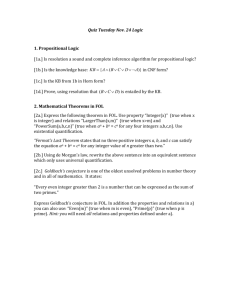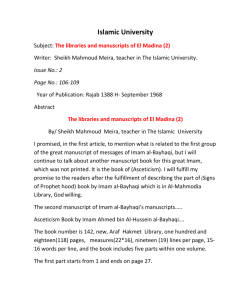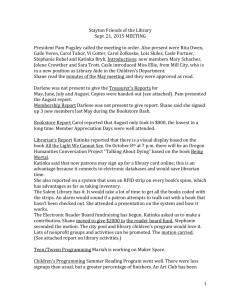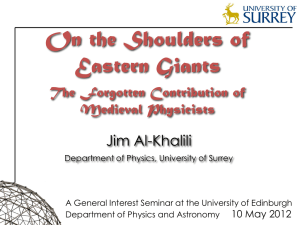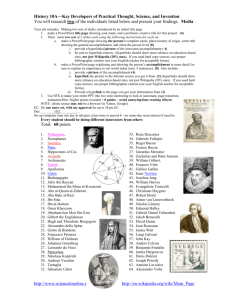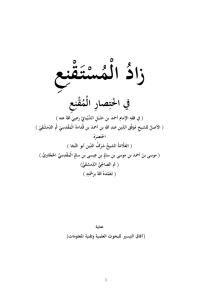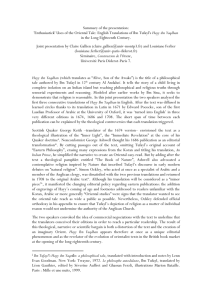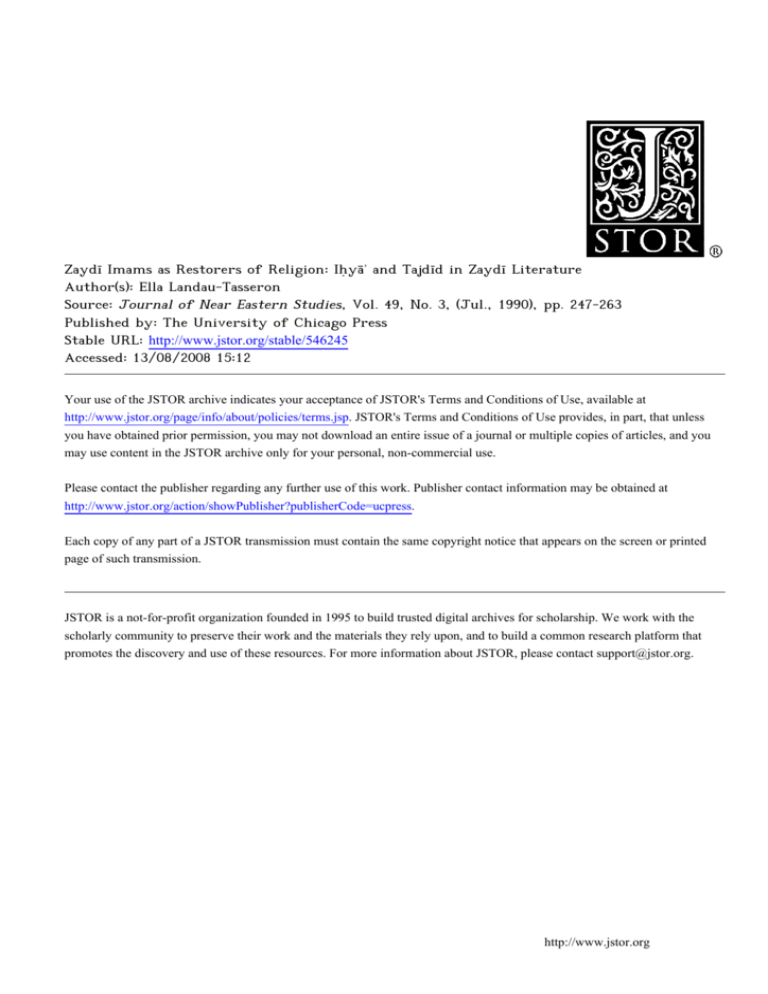
Zaydī Imams as Restorers of Religion: Iḥyāʾ and Tajdīd in Zaydī Literature
Author(s): Ella Landau-Tasseron
Source: Journal of Near Eastern Studies, Vol. 49, No. 3, (Jul., 1990), pp. 247-263
Published by: The University of Chicago Press
Stable URL: http://www.jstor.org/stable/546245
Accessed: 13/08/2008 15:12
Your use of the JSTOR archive indicates your acceptance of JSTOR's Terms and Conditions of Use, available at
http://www.jstor.org/page/info/about/policies/terms.jsp. JSTOR's Terms and Conditions of Use provides, in part, that unless
you have obtained prior permission, you may not download an entire issue of a journal or multiple copies of articles, and you
may use content in the JSTOR archive only for your personal, non-commercial use.
Please contact the publisher regarding any further use of this work. Publisher contact information may be obtained at
http://www.jstor.org/action/showPublisher?publisherCode=ucpress.
Each copy of any part of a JSTOR transmission must contain the same copyright notice that appears on the screen or printed
page of such transmission.
JSTOR is a not-for-profit organization founded in 1995 to build trusted digital archives for scholarship. We work with the
scholarly community to preserve their work and the materials they rely upon, and to build a common research platform that
promotes the discovery and use of these resources. For more information about JSTOR, please contact support@jstor.org.
http://www.jstor.org
ZAYDI IMAMS AS RESTORERS OF RELIGION:
IHYA' AND TAJDID IN ZAYDI LITERATURE*
ELLA LANDAU-TASSERON,HebrewUniversity,Jerusalem
I
THE modern Yemeni historian Muhammad b. Muhammad b. Yahya Zabara
(d. 1380/1960) wrote a short history of the Zaydi imams, beginning with Zayd b. 'All
and ending with his own contemporary al-Mutawakkil 'ala Allah, who was recognized
as imam in 1322/1904. The book consists of a poem (urjiza) and a commentary upon
it and is entitled A Gift Presented to the Rightly Guided: Concerning the ImamsRestorers and the Rulers of the Yemenfrom among the Descendants of the Prophet,
Adherents of the Qur'dn (Ithdf al-muhtadrn bi-dhikr al-a'imma al-mujaddid'n waman qdma li-l-yaman al-maymun min qurand' al-kitdb al-mubTnwa-abn3' sayyid alanbiyd' wa-l-mursalTn [San'a', 1343]). The term "restorers," mujaddidTn, which
appears in the title, recalls the hadith "God will send to this community at the turn of
each century someone (or 'people') who will restore the religion" (inna allah yab'ath
li-hddhihi al-umma cald ra's kull mi'a sana man yujaddid lahd amr dTniha). I have
dealt with this hadTth extensively in a separate article, but the main points are
summarized below for the purpose of the present article.1
The earliest occurrence of this hadith is in the third century in the Sunan of Abu
Da'ud. Several medieval authors quote it from Abu Dauid, invariably attaching to it
lists of people designated as mujaddidun. Whatever the original meaning was, at some
point tajdid came to be explained as, or identified with, ihyda al-sunna. This in turn
may mean the revival of past forgotten practices and ideas of the Prophet or the
defending of the orthodoxy from unwelcome innovations. Generally speaking, however, it was not the concept of revival-restoration which interested medieval writers, in
that they were not concerned about devising a mechanism which would make revival
possible; nor did they formulate criteria for the identification and designation of
mujaddiduin,except the general stipulations that they should be great scholars and/or
champions of the Sunna against bidca. Medieval authors were interested in the identity
of those designated as mujaddidiin, often enhancing the prestige of a scholar (or
scholars) whom they favored. They usually abided by the criterion supplied by the
* I gratefully acknowledge the support of the
Lady Davis Fellowship Trust, and thank the Curator
of Oriental Collections at the University of Leiden,
[JNES 49 no. 3 (1990)]
? 1990 by The University of Chicago.
All rights reserved,
0022-2968/90/4903-0002$1.00.
J. J. Witkam, and his assistants J. Linssen and the
late W. van Wiggen. I also wish to thank my
colleagues E. Kohlberg and F. Donner for their
valuable comments on drafts of this paper. Thanks
are also due to P. von Sivers and the scholars whom
he consulted. Some of their many comments were
useful.
I See my article "The Cyclical Reform: A Study
of the mujaddid hadTth,"Studia Islamica 70 (1989):
79-117.
247
248
JOURNAL OF NEAR EASTERN STUDIES
hadTthitself, i.e., the time limitation. Thus the mujaddidun are, as a rule, scholars of
the religious sciences who happened to die shortly after the turn of a given century.
Usually, several restorers are mentioned for each century, which is probably the result
of harmonizing and standardizing various previous lists. An examination of the lists
shows that, starting with al-Shafi'c (d. 204/819) and until the sixth century A.H., the
Sunni mujaddidun were jurists and theologians who strove to make the Prophetic
tradition (hadLth) predominate over personal judgment (ra'y) and who defended
Orthodoxy, even while it was still in the process of crystallizing, against groups which
they considered non-orthodox. In other words, the Sunni mujaddidun of the third to
the sixth centuries were scholars who were engaged in polemics against non-Sunni
Muslims. All of these majaddidun were active in the eastern centers of learning, in
Iraq and Iran. Between the seventh and the tenth centuries A.H. we find a number of
restorers in Cairo. Unlike their eastern predecessors, these mujaddidun were not
famous for their polemical activity in particular but acquired their title because of
their remarkable knowledge and scholarly activity.
Most of the mujaddidun mentioned in the standard lists are ShaficTs, as are the
transmitters of the mujaddid hadTthmentioned above. Yet there is evidence suggesting
that the use of the title mujaddid was not confined to the Shafi'C madhhab. Ibn alAthir and Ibn Kathir state that every school applied the title to its own masters. The
list compiled by Ibn al-Athir, however, is not merely a collection of the names of such
masters because it is very systematic. Rather, it appears that Ibn al-Athir himself,
acting against the fanaticism of any particular school or faction, compiled a comprehensive list which includes scholars from many schools, places, and religious sciences,
as well as caliphs and even Imami ShCl's.2
Ibn al-Athir's list is comprehensive, but it does not include Zaydi imams; yet, as
mentioned above, the Yemeni historian Zabara applies the title mujaddid systematically to ZaydTimams. This paper is the result of an attempt to investigate the use and
significance of this title in ZaydT tradition as compared with its SunnTcounterpart.
Such an investigation may provide a new view concerning the nature of ZaydT
leadership, as well as insight into the Zaydi use of a Sunni hadTth.
It should first be noted that Zabara singles out as mujaddidun twenty-three of the
one hundred and twenty imams he mentions. These are distributed more or less evenly
over the thirteen centuries of Islamic history, thus forming a complete Zaydi list of
restorers independent of the Sunni one. As we shall see below, this is not the only
Zaydi list, and it is noticeable that Zabara himself is inconsistent in at least one case,
that of al-HadT ila al-Haqq (d. 290/903), whom he sometimes calls mujaddid yet
whom he does not include in his list.3 Zabara's application of the title calls for several
2 Jalal al-DTn al-Suyutl, al- Tanbi'a bi-man yabcathuhu allah Caldra's kull mi'a, MS Leiden Or. 474,
fols. 79b-80a.
3 The list is in M. b. M. Zabara al-Hasani, Ithaf
al-muhtadTn bi-dhikr al-a'imma al-mujaddidTnwaman qdma bi-l-yaman al-maymun min quranda alkitdb al-mubTn wa-abnd' sayyid al-anbiy&' wa-lmursalin (San'a', 1343), pp. 4-6; cf. idem, Abnda
al-yaman wa-nubald'ihi bi-l-islam (Cairo, n.d.),
p. 39; idem, Khulasat srrat al-hddT, appended to
idem, al-Inba' Can dawlat bilqrs wa-saba' (Cairo,
1376), p. 3, where he refers to al-HadT as mujaddid.
This Khuladsais taken from a work entitled Urjiuzat
al-a'imma. It may well be that the latter is identical
with the Ithaf (which is also an urjuza), as the
refrain is identical. I was unable to check it because
I could not find the Urjuizatal-a'imma, and the
biography of al-HadT which is the Khulasa is missing in the printed edition of the Ithaf. As for alHadd himself, he was not unanimously recognized
ZAYDI IMAMS AS RESTORERS OF RELIGION
249
comments, which are listed in what follows under four headings. These comments
indicate the differences between the Zaydi and SunnYrestorers.
The Disregardfor the Hundred- YearMotif
According to the mujaddid hadTth,a restorer is due every hundred years at the turn
of each century. Accordingly, it was stipulated for the Sunni mujaddidun that they be
dead shortly after the turn of the century, and only rarely was this rule broken.
Zabara, on the other hand, disregards this rule. In the introduction to his Ithdf, he
quotes the mujaddid hadTth verbatim and appends to it commentary from his
predecessors which stresses and explains the hundred-year motif; he also assigns his
mujaddidun to their respective centuries. Yet the long list which he adduces immediately afterwards includes many imams whose death dates do not coincide with the turn
of the century. Had he considered dates of major events in their lives instead of their
deaths, one would have expected an explanation, as given by the Sunnis when they
designated as mujaddid al-Ash'ari, who died in 323/934 (too late for the "turn of the
century").4 Even so, there are imams who do not fit in the hundred-year motif in any
way. This may indicate that the ZaydT way of designating mujaddidun was less
mechanical than the Sunni one because they disregarded the hundred-year rule, which
after all, is gratuitous: people qualified to bear the title mujaddid might be active, or
die, at any time during the century.
The Regal Aspect of the Title
The Sunny restorers are almost always scholars (supposedly the finest ones of their
time) with the following exceptions: (1) 'Umar b. 'Abd al-'AzTz. It was, however, not
his caliphal status which earned him the title but his (alleged?) activities in the field of
hadTth.5(2) The fifth mujaddid in the standard SunnTlists is al-Ghazali, but in the list
recorded by Ibn 'Asakir (on the authority of a Damascene muft), the caliph alMustarshid bi-Allah is substituted for al-Ghazali. Ibn 'Asakir himself raises objections
to this substitution on the ground that al-Ghazali is more deserving of the title, since
he was such an outstanding religious scholar.6 (3) In the comprehensive list of
mujaddidin compiled by Ibn al-Athir, a caliph is included for each century, alongside
jurists, Qur'an readers, muhaddithun, etc.
Unlike the Sunni list, Zabara's list of Zaydi restorers consists mainly of political
leaders who were proclaimed heads of the community, i.e., imams. This is not to say
that they were not scholars as well; on the contrary, they were supposed to be the
finest scholars, since the Zaydi head of the community is invariably an imam of the
as mujaddid. See Muhammad b. 'Abdallah Ibn alMu'ayyad (Abiu Ulama), Rawdat al-albab watuhfat al-ahbab, MS Berlin Ahlw. 9402, fol. 12b.
4 The SunnTs explain that al-Ash'arT converted
from Mu'tazilism to Sunnism at the turn of the
century, in the year A.H. 300. See, for example, 'Ali
b. al-Hasan Ibn 'Asakir, TabyTnkadhib al-muftarT
fTma nusiba ila al-imam abT al-hasan al-ash'arr
(Damascus, 1347), p. 56.
5 See my article "Cyclical Reform," pp. 112-13.
See also P. Crone and M. Hinds, God's Caliph:
Religious Authority in the First Centuries of Islam
(Cambridge, 1986), p. 80.
6 Ibn 'Asakir, TabyTnkadhib al-muftarl (Leiden,
1878), p. 83. The Damascene mufti is Abu al-Hasan
al-Sulam (d. 533/1139).
250
JOURNAL OF NEAR EASTERN STUDIES
family of the Prophet and, as such, should constitute the highest religious authority and
the source of knowledge (macdan al-'ilm). He stands at the top of the hierarchy of
excellence and is greatly admired and held in the highest esteem. It does not therefore
seem conceivable that the title "restorer of religion" should apply to anyone but an
imam. On the other hand, when applied to the ZaydTimams, the title mujaddid must
denote more than mere recognition of scholarly excellence; that in fact it does, will, I
hope, be shown below. It is also clear why the Sunni list of mujaddiduincan vary and
include caliphs alongside scholars, whereas the Zaydi list does not. In Sunni Islam, the
caliphs share with the scholars the task of defending the true faith. By analogy, they
may also share with the scholars the task of restoring and reviving the faith. In fact,
caliphs and scholars strive for the same end through different means-the caliphs
using power (enforcing the sharC'aand performingjihad) and the scholars disseminating knowledge. For the Zaydis, the bearer of these responsibilities is the imam, who
uses both methods, being himself the embodiment of power and knowledge alike;
hence, there is no place for mujaddidun beside the imam. Thus there is in the Zaydi
use of the title mujaddid a regal aspect which is almost entirely lacking in the Sunni
notion of tajdTd.
Types of Mujaddidiun
Zabara makes a distinction between three types of mujaddiduin:(1) mujaddid bisayfihi, the imams who restore religion by waging war on those who distort it;
(2) mujaddid bi-cilmihi, the imams who perform the same task by disseminating
knowledge; and (3) mujaddid bi-sayfihi wa-'ilmihi, the imams who use both methods.
Most of the mujaddidun belong to the third type and are both leaders of jihad and
authors of religious books, as indeed they should be according to the idea of the ZaydT
imam described above. Jihad against whoever opposes his legitimate rule is incumbent
upon the imam, and knowledge is both a prerogative inherent in his office and a means
of legitimizing his claim to this office.7 There were imams, however, who did not meet
7 On jihad, see, for example, 'All b. Muhammad
b. 'Ubaydallah al-cAbbasT,STratal-hadd ild al-haqq
yahyd b. al-husayn (Beirut, 1972), pp. 23, 27 ff.; alMansir bi-Allah CAbdallah b. Hamza, al-'lqd althamTnfi tabyTn ahkdm al-a'imma al-hddTn, MS
Brit. Lib. Or. 3976, fols. 15b, 82b, 139b-140a, 142a;
Humaydan b. al-Hasan b. al-Qasim, Kitab al-tasrTh
bi-l-madhhab al-sahih, MS Brit. Lib. Or. 3727, fol.
109a; R. Strothmann, "Die Literatur der Zaiditen,"
Der Islam 1 (1910): 367; idem, Das Staatsrecht der
Zaiditen (Strasbourg, 1912), pp. 43-45, 59; A. K.
Lambton, State and Government in Medieval Islam
(Oxford, 1981), p. 30. On knowledge: Humaydan,
TasrTh,fols. 119a, 121b; al-Mansur bi-Allah CAbdallah b. Hamza, Ajwibat masd'il tatadamman dhikr
al-mutarrifiyya, MS Brit. Lib. Or. 3976, fol. 218a;
Humayd b. Ahmad al-MahallT, al-Hada'iq alwardiyya fT dhikr a'immat al-zaydiyya, MS Leiden
Or. 2626, fol. 4b; al-Hasan b. Badr al-Din alHadawi, Anwdr al-yaqTn, MS Brit. Lib. Or. 3868,
fols. 41a-b, 74b, 77b, 86b, 116a, 126a; Sirat al-hadi,
p. 342; Abu Muhammad Yisuf b. Muhammad al-
Hajuri, Rawdat al-akhbdr wa-kunuz al-asrar wanukat al-'athdr wa-mawd'iz al-akhbdr, MS Bib.
Nat. Cod. Arab 5982, fols. 82b-83a (this manuscript
has previously been attributed to al-Lah.j and was
identified by W. Madelung as al-Hajuir's Rawda.
See W. Madelung, "The Identity of Two Yemenite
Historical Manuscripts," JNES 32 [1973]: 175-80;
and D. T. Gochenour, "A Revised Bibliography of
Medieval Yemeni History in Light of Recent Publications and Discoveries," Der Islam 63 [1986]:
311); Lambton, State and Government, p. 29. Strothmann, "Die Literatur der Zaiditen," Der Islam 2
(1911): 67; idem, Staatsrecht, pp. 68 ff., 104 (the last
reference is to a passage quoted by Strothmann
from al-Natiq bi-l-Haqq, in which both jihad and
knowledge are mentioned, among other things, as
being required of the imam); C. Van Arendonk,
Les Debuts de l'imamat zaidite au Yemen, trans.
J. Ryckmans (Leiden, 1960), p. 273; Madelung, Der
Imam al-Qdsim b. Ibrdhrm und die Glaubenlehre
der Zaiditen (Berlin, 1965), p. 144.
ZAYDI IMAMS AS RESTORERS OF RELIGION
251
all the requirements yet who were recognized as legitimate. Thus the political failure of
al-Qasim b. IbrahTm(d. 246/860) did not prevent him from being recognized as one of
the most important imams because of his pivotal role in systematizing Zaydi theology.
The ZaydTs learned to make concessions to reality, first of all, for example, by
ignoring success and failure. The legitimacy of the imams does not depend on their
actual victory but on their attempts to achieve it. Secondly, as pointed out by R.
Strothmann, the Zaydis resorted to a distinction between two types of imams, both
legitimate, imams of war and imams of learning.8 Apparently, this was done precisely
because many imams did not live up to the ideal with both the sword and the pen.
Zabara copied this distinction between types of imams and applied it to the mujaddidun. There is, of course, no such distinction as regards the Sunni restorers, nor is
there any other attempt at dividing them into types.
Zabara makes an effort to distribute evenly his twenty-three restorers in terms of
both geography and typology. In most cases, he mentions contemporaneous mujaddidin in the Yemeni and Caspian ZaydTstates, and when designating a "restorer-bythe-sword," he attaches to him as a counterpart a "restorer-by-knowledge." One
example of the former is Muhammad b. Ibrahim, who led a ShT'c revolt in Kufa
in 199/815. His counterpart ("restorer-by-knowledge") is his brother, the abovementioned al-Qasim b. IbrahTm, who in fact was the first to systematize Zaydi
theology and jurisprudence.9 The importance of al-Qasim is reflected in the application to him of the saying of the Prophet "if there was to be a prophet after me it would
have been he." (This hadTth was also applied to great figures such as cUmar b. alKhattab, Ibn Hanbal, and al-GhazalT.)'1 Another mujaddid bi-sayfihi is al-Mansuir
bi-Allah cAl b. Salah al-Din (d. 840/1436), and his counterpart is Ahmad b. Yahya b.
al-Murtada (also d. 840/1436). The latter was a prolific writer of paramount importance who wrote fundamental works in the fields of theology and fiqh." The former,
al-Mansur bi-Allah, was continuously engaged in war, thus conforming to the ideal of
jihdd. That his enemies were often Zaydis themselves whose only fault was that they
did not recognize his rule does not make al-Mansiir's wars less holy as far as he was
concerned. Yet placing him and Ibn al-Murtada as complementary mujaddidun seems
somewhat absurd because the mujaddid is supposed to fight the enemies of religion,
and these two fought one another over power and rule. In 794/1392, the mujaddid
bi-sayfihi al-Mansuir bi-Allah 'Al1 took prisoner the mujaddid bi-'ilmihi Ahmad b.
Yahya b. al-Murtada..2 To sum up, the ZaydTsdrew the distinction between types of
imams in order to solve two concrete problems: the existence of imams who were
lacking in one of the two qualifying aspects (military ability and knowledge) and the
8 Strothmann, Staatsrecht, pp. 71, 90, 98; idem,
"Zaydiyya," EI1. Strothmann does not treat separately the third type which combines both. See also
Madelung, Der Imam, pp. 141 ff., and D. T.
Gochenour, "The Penetration of ZaydT Islam into
Early Medieval Yemen" (Ph.D. diss., Harvard University, 1984), chap. 5 n. 214.
9 Strothmann, "Literatur," Der Islam 2 (1911):
49-60; Madelung, Der Imam.
10See my "Cyclical Reform," p. 82. Al-Farazdaq
applies the same to the caliph YazTdII : Crone and
Hinds, God's Caliph, p. 30, n. 25. The application
to al-Qasim is in al-HadawT, Anwdr al-yaqfn (Brit.
Lib.), fol. 139b.
11C. Brockelmann, Geschichte der arabischen
Literatur, Supplement (GAL S) (Leiden, 1937-42),
vol. 2, pp. 244-45; Strothmann, "Literatur," Der
Islam 1 (1910): 362, 371.
12Yahya b. al-Husayn, Ghdyat al-amadnf Takhbar
al-qutr al-yamanT (Cairo, 1388/1968), vol. 2, pp.
538-40, 544-46, 547. For a description of the incessant wars in which al-Mansuir bi-Allah 'All was
involved, see ibid., pp. 538-73.
252
JOURNAL OF NEAR EASTERN STUDIES
simultaneous existence of two imams or more.13 Since the mujaddidun are always
imams, this typological distinction automatically applies to them. However, while
solving the above-mentioned problems, this distinction creates a new problem because
it brings out the unfortunate reality of discord and war among members of the
venerated House of the Prophet.
Lack of Evidencefor Earlier Occurrencesof the Title
Zabara composed his urjuza on the basis of material found in the history books of
his predecessors. His commentary on the urjuiza necessarily draws upon the same
sources for the simple reason that he did not invent the history which he wrote. He
cites several sources, usually ascribing to each of them the specific material which he
drew from it. Not once does he ascribe to an earlier source the designation of an imam
as a mujaddid. But, as we shall see, Zabara was no innovator in this matter. Some of
the notions associated with the mujaddid have deep roots in the Zaydi tradition, and
the term mujaddid itself was eventually applied to ZaydTimams, although sparingly.
The relation between these notions, the title mujaddid, and the mujaddid hadith will
be examined in the following pages.
On the surface, it appears that the idea of restoration is incompatible with Zaydi
doctrines because it presupposes a period of deterioration. Restoration is needed at the
end of each century because, as Suyuti puts it, by that time the scholars of the century
have died, the ways of the Prophet have been forgotten and innovations introduced.14
Theoretically, such a state of deterioration cannot occur according to the Zaydis
because of the principle of the continuity of guidance. One frequently finds in Zaydi
literature the following hadtth: "the people of my House are like the stars, whenever
one of them sets another one rises," that is, by God's decree there is always an imam
of the ahl al-bayt to guide the community.15 The idea of continuity assumes other
forms as well: the chain of prophets culminated in Muhammad, then God gave his
Prophet the progeny of his daughter and his cousin to be the people's guide after
him.16 The people cannot at any time be without a ruler who rules according to God's
book;'7 at all times, there must be among the ahl al-bayt people qualified to be
imams;18 "knowledge always has guardians, as long as the nights follow the days";'9
13See n. 8 above.
14 Suyut.?,Tanbia,
fol. 80b.
15 Ahl baytTka-l-nujum kullama
afala najm tala'a
najm: al-Hadawi, Anwar al-yaqTn(Brit. Lib.), fols.
192b-193a; cf. 78a; Ibn al-Mu'ayyad, Rawda, fol.
12a; Muhammad b. 'Abdallah b. al-Husayn alMihrabi, al-Jawabdt al-hashimiyya f al-radd cald
ba'd al-shafi 'iyya, MS Brit. Lib. Or. 3727, fol. 22a;
Humaydan b. Yahya b. Humaydan, al-Farq bayna
al-tashayyuc wa-l-i 'tizal, MS Brit. Lib. Or. 3727,
fol. 48a. Variations on the star theme: al-Hadawi,
Anwar al-yaqTn (Brit. Lib.), fol. 66a; Sibt Ibn alJawzT,Tadhkiratkhawass al-umma bi-dhikr khasais
al-a'imma, MS Leiden Or. 915, fol. 193b; al-HadT
ila al-Haqq, Durar al-ahadith al-nabawiyya bi-l-
asanTdal-yahyawiyya (Beirut, 1982), p. 52.
16 Al-Husayn b. Ahmad b. Ya'qub, Strat almansur bi-alldh, MS Brit. Lib. Or. 3816, fol. la-b.
17 Humaydan (quoting al-Murtada li-DIn Allah
Muhammad b. Yahya), TasrTh,fol. 121b.
18Humaydan (quoting al-Mansur bi-Allah 'Abdallah b. Hamza), Farq, fol. 50a. Of course there was
a discrepancy between the ideal and reality; see, for
example, Gochenour, "Zaydi Islam," p. 200.
19 Wa-li-l-'ilm hafaza f jamT' al-acsar md ikhtalafa yawn wa-nahar. Al-Mansuir bi-Allah CAbdallah b. Hamza, al-Jawhara al-shaffafa rddiCataltawwafa, MS Brit. Lib. Or. 3976, fol. 236a, where
other expressions of the same idea also occur.
ZAYDT IMAMS AS RESTORERS OF RELIGION
253
there is no way by which the sharT'a can be changed or falsified says al-Mansur biAllah because the whole community knows it and will not permit it.20 Nevertheless,
the same author quotes a hadTth concerning innovations: it says that for every
innovation introduced in Islam there is assigned someone of the ahl al-bayt to rectify
its damages and show the people the truth.21Zayd b. 'All is quoted as saying that God
sends to every generation someone from the ahl al-bayt as "Proof of the Truth"
(hujja).22All these expressions of the idea of continuity mean the same thing: there is
always just rule by rightly-guided imams from among the ahl al-bayt; hence, there is
no place forfatra, an "interval"; no deterioration may occur, and there is no need for
tajdTd, "restoration." Nevertheless, the ideas of fatra, deterioration, and tajdTd do
figure in ZaydTtradition.
At the beginning of the seventh/thirteenth century, al-Mansur bi-Allah states that
Zaydis, Imamis, Mu'tazills, and most Sunnis all share the doctrine of continuity.23
But the founder of Zaydi theology, al-Qasim b. Ibrahim, considered the Imamis comparable with the Brahmin atheists because of this very doctrine. Basing his ideas on
al-Qasim, Strothmann assumed that the Zaydis as a rule maintained the fatra
doctrine, which is opposed to the idea of continuity.24A confirmation of Strothmann's
assumption seems to be found in the fact that al-Mansuir bi-Allah al-Qasim b.
Muhammad (d. 1029/1620) wrote a book entitled Guidancefor the Servants of God in
the Absence of a Director.25 W. Madelung, however, has pointed out that al-Qasim
b. Ibrahim was inconsistent regarding thefatra doctrine; he used it to refute the Imami
doctrine of wasiyya (a form of the continuity idea). Yet, on the other hand, al-Qasim
also argued that an imam was always necessary on the grounds that Allah cannot leave
the people without guidance.26It seems to me that although there is evidence in Zaydi
literature of both fatra and continuity doctrines, the latter is the more typically
ZaydT.This also makes sense historically, given the uninterrupted political existence
of ZaydTs in the Yemen.27 But the doctrine of fatra serves ZaydT purposes, too. In
20 Idem, al-'Iqd al-thamin, fols. 80a, 128b-129a,
131b.
21 Ibid., fol. 142a; al-Mansur bi-Allah, al-Jawhara,
fol. 270a; idem, Kitab al-shafi, MS Berlin Ahlw.
10281, fol. 2a. The same idea in another hadith:
al-Hadawl, Anwar al-yaqin (Brit. Lib.), fol. 77a-b.
22 Al-Mansur bi-Allah, al-CIqdal-thammn,fol. 56a.
Cf. Gochenour, "ZaydTIslam," pp. 46, 79: "Zaydis
repudiated the idea of a hidden imam or one who
was for the moment removed from material existence," and they "put particular stress on the present
existence of the imam." Of course ghayba and fatra
are different theological issues, but in the present
context it is the idea of the continuous guidance
which is stressed.
23 Al-Mansur bi-Allah 'Abdallah b. Hamza, alDurra al-yatTma fi tabym ahkdm al-siba' wa-lghanTma,MS Brit. Lib. Or. 3976, fol. 202a.
24 Strothmann, Staatsrecht, pp. 91 ff.; and see
Gochenour, "Zaydi Islam," pp. 181-82, 200, on the
Husayniyya or Qasimiyya.
25 A. S. Tritton, The Rise of the Imams of San'a'
(London, 1925), p. 128. This is not the same al-
Mansur mentioned in the previous notes. Tritton
does not give any detail on this book, and I was
unable to trace it.
26
Madelung, Der Imam, p. 146. For a critique of
Madelung's view, see B. Abrahamov, "The Theological Epistle of al-Kasim b. IbrahTm"(Ph.D. diss., Tel
Aviv University, 1981) (in Hebrew), vol. 1, p. 126.
Al-Qasim's epistle in which he uses the doctrine of
fatra is Kitab al-radd 'ala al-rdfida. The epistle in
which he bases himself on the continuity doctrine is
Kitab tathbft al-imdma, both edited by Abrahamov,
vol. 2, pp. 310-21 and 204-23 respectively.
27This holds true even though there were periods
in which the ZaydTs had hardly any control in the
Yemen, since, ideally, the Zaydi communities do not
cease to constitute political entities even when (temporarily) overcome by other powers. Thus it is
possible for Zabara to say that the Zaydis "ruled the
Yemen for more than 1000 years." M. b. M. Zabara,
Yemen- Traditionalism versus Modernity (New
York, 1982), p. 5; and in the same vein, M. A.
Madi, "Dawlat al-yaman al-zaydiyya, nash'atuha,
tatawwuruha, 'alaqatuha," al-Majalla al-ta'rrkhiyya
254
JOURNAL OF NEAR EASTERN STUDIES
addition to refuting the Imami wasiyya-doctrine, it also provides the background for
the appearance of prophets and helps to bridge the gap between the real and the ideal,
i.e., between the fact that morals and religion are always in an undesirable state and
the notion that God constantly provides guidance. The idea offatra reconciles these
two facts by showing that the periods during which ignorance prevails and deterioration occurs are regularly halted by God's successive agents: prophets, imams, mujaddidun. Of course, the contradiction may be resolved without the device of thefatra, by
the argument that guidance is always present, but that people sin and fail to follow it.
At any rate, it appears that the contradictory ideas of continuity and deterioration
coexist in Zaydi thought, both being organic elements of it. The ZaydTconcept of the
ahl al-bayt, their status, and their qualities, coupled with the fact that ahl al-bayt is a
genealogical entity, entails the idea of continuity. On the other hand, the concept of
deterioration fits into Zaydi thought not only because of its connection with the
doctrine offatra, but also because of the similarity between the figures of the imam
and the ultimate Mahdi. As a result of this similarity, the period of the "Portents of
the Hour" (ashrat al-sa'a), which precedes the appearance of the Mahdi, was transferred and became a period of deterioration which precedes the advent of an imam or
a mujaddid.
The similarity between the head of the community and the eschatological Mahdi
cuts across sectarian lines and is common to all groups of SunnTs and Shicis. It is
expressed in various forms, first and foremost by the application of the title Mahdi to
caliphs and imams.28In addition, the imams and the Mahdi are sometimes referred to
by the same terms. For instance, according to the messianic ideal put in the form of a
hadTth, the Mahdi "will fill the world with justice as it is filled with evil/injustice."29
The same words are applied to many Zaydi imams either as prophecies of their advent
or as epithets.30 The advent of the imam al-HadT ila al-Haqq is prophesied in hadTths
phrased in an eschatological style and using apocalyptic terms, as, for example, "when
the Egyptians have killed their governor and the Yemeni will arise, he will fill the earth
with justice .. .. 31
al-misriyya 1-3 (1950): 15, 33-34. It is also noteworthy that the list of imams compiled by Zabara in
the Ithaf hardly allows for significant intervals between one imam and the next, but these imams do
not succeed one another as heads of one and the
same community. Moreover, they often fight one
another. See also n. 12 above, and Gochenour,
"Zaydi Islam," pp. 169, 208.
28 Madelung, "Mahdi," El2; Crone and Hinds,
God's Caliph, pp. 36 ff., 75, 102-3, 113-14.
29 See, for example, al-Mansur bi-Allah,
al-'Iqd
al-thamTn, fols. 55a, 58a, 59a-b. Cf. Strothmann,
Staatsrecht, pp. 46-48, on the Twelfth Imam, who
will return for this purpose.
30 For example, STrat al-hadi, p. 330; al-Hadi,
Durar al-ahadTth, p. 192, n. 1; al-Mansir bi-Allah,
al-'Iqd al-thamTn, fol. 53a. Cf. the version of the
hadrth used to praise the tribe of Quraysh: "Do not
curse the Quraysh because their scholar will fill the
world with knowledge" (la tasubbtu qurayshan fainna 'alimahd yamla' al-ard 'ilman), Ibn Hajar alCAsqalani,Tawdll al-ta'sis bi-maadlTibn idrts (Bulaq,
1301), pp. 46-47; Taj al-Din al-SubkT, Tabaqat alshafi'iyya al-kubra (Cairo, n.d.), vol. 1, p. 104. Ibn
CAsakir,Tabyrn(Leiden), p. 82. Al-Farazdaq refers
to the caliph Hisham by the same terms; Crone and
Hinds, God's Caliph, p. 37, and cf. ibid., p. 114 (on
the caliph 'Umar II).
31 Idhd qatala ahl misr amTrahumwa-zahara alyamandf al-yamanfa-innahu yamla' al-ard 'adlan;
STrat al-hddi, p. 29, and see the prophecies there
and on pp. 25-26; al-Hadawi, Anwar al-yaqfn (Brit.
Lib.), fol. 149b. For a description of al-Hadi in
messianic terms, see Van Arendonk, Les Debuts,
pp. 269-70, and cf. ibid., pp. 132-33, for another
prophecy in the apocalyptic style.
ZAYDI IMAMS AS RESTORERS OF RELIGION
255
Terms are transferable not only from the Mahdi to the imam but also vice versa.
Just as caliphs and imams are referred to as mahdis, so the Mahdi is called khalifat
allah32 (the ZaydTs, however, do not use the term).33 One of the tasks of the Zaydi
imam is "to enjoin good and prohibit evil" (al-amr bi-l-ma'rif wa-l-nahy Canalmunkar).34 Conversely, the application of this precept is a token by which the ZaydT
imams are recognized.35The Qur'anic verse upon which this precept is based is even
used to try to prove that the ZaydTdoctrine of the Imamate is the only right one.36
Evidently, al-amr bi-l-ma'rif belongs in the affairs of this world; yet it also finds its
place in eschatology. In a passage describing the Mahdi, we find that the time
preceding his coming will be characterized by annihilation of the ways of the Prophet,
introduction of innovations, and neglect to enjoin good and prohibit evil; Allah will
then send the Mahdi to remedy the situation.37 Thus the injunction of al-amr bi-lmac'rf is transferred from the imam to the Mahdi. Interestingly, it is precisely this
injunction which is used in an attempt at differentiating between the Mahdi and the
imam: IbrahTmb. 'Abdallah was asked whether his brother, al-Nafs al-Zakiyya, had
been the Mahdi. He replied that the Mahdi was a Divine Promise which was never
specified by name or time; even if al-Nafs al-Zakiyya was not the Mahdi, he
nevertheless fulfilled the task assigned to him by God, which was to enjoin good and
prohibit evil.38 Such attempts, however, are overshadowed by the tendency of the
figures of the Mahdi and the imam to intermingle. A passage may even be ambiguous,
leaving it to the reader to decide whether the Mahdi or an imam is meant. A prophecy
ascribed to CAli describes a future time in which innovations will multiply and the
ways of the Prophet be wiped out, so that the world will be filled with injustice;
God will then remedy the situation by sending a man of the ahl al-bayt to fill the
world with justice.39 Since both the imam and the Mahdi are members of the ahl
al-bayt, the prophecy may in a similar manner refer to the advent of any given imam
and the ultimate Mahdi. From the last passages it is evident that the parallelism
between the imam and the Mahdi extends to the period preceding the advent of either.
The deterioration theme is a pale reflection of the horrendous "Portents of the Hour"
(ashrat al-saa), just as the imam reflects the Mahdi. Connected in this way with the
concept of Mahdi/imam, the deterioration theme thus belongs to Zaydi thought, even
though it clashes with the basic doctrine of continuity.
In addition to being a reflection of an apocalyptic idea, the deterioration theme may
be seen on a pragmatic level as a tool used in propaganda. A deteriorated state of
affairs justifies the rise of an imam and his claim to establish and lead a new order.
32 Crone and Hinds, God's Caliph, p. 16.
Debuts, pp. 51, 56, n. 1, 135, 137, 164, 288; Stroth33 Ibid., p. 18, n. 63.
mann, Staatsrecht, pp. 42-43, 105.
34 Sirat al-hadT, pp. 28, 298, and passim; al-HadT
35 Al-Hadi, Durar al-ahadTth, p. 48 (quoted also
ila al-Haqq, Usul al-dTn, MS Brit. Lib. Or. 3798, by Strothmann, Staatsrecht, and by Crone and
fols. 68a-69b; al-Hajirl, Rawdat al-akhbar, fols. Hinds, God's Caliph, p. 98, n. 12).
36 Al-HadawI, Anwar
182b, 188a, 196b; al-Mansir bi-Allah, al-'Iqd alal-yaqTn (Brit. Lib.), fol.
thamTn,fols. 47a, 68a, 80a, 140a; idem, al-Durra al- 102a-b. The verse is sura 3:104.
37Al-Mansur bi-Allah, al-'lqd al-thamTn,fol. 60b.
yatTma,fols. 170b, 180a; idem, Ajwibat masa'il, fol.
38 Van Arendonk, Les Debuts, p. 56, n. 1, quoting
280a; al-HadawT, Anwar al-yaqTn (Brit. Lib.), fols.
74b, 150a, 176a; al-Natiq bi-l-Haqq Yahya b. al- al-Mahall's al-.Had'iq al-wardiyya.
39 Al-Hadaw1, Anwdr al-yaqTn, MS Leiden, Or.
Husayn, al-Ifdda f ta'rTkhal-a'imma al-sada, MS
Leiden Or. 2616, fols. 49b, 45b; Van Arendonk, Les 14.266, fol. 63b.
256
JOURNAL OF NEAR EASTERN STUDIES
This is clearly illustrated by the imam al-Mu'ayyad bi-Allah (end of the fourth
century, eastern Zaydi state). In a propaganda speech, he describes the cycles of evil
and redemption through Islamic history from al-Husayn b. 'All down to his own
period: time and again evil prevailed and the righteous (i.e., Zaydl) imams rose against
it, each in his turn. Al-Mu'ayyad presents himself as the new link in that chain and
urges his listeners to support him in order to overcome the current evil.40 The same
idea figures in the words attributed to Zayd b. 'All: "... it is a long time since the
4
The implication is
Prophet died and nothing remained of Islam but the name ..
that the time has come to restore things to the way they were at the time of the
Prophet. The idea of restoration or revival in fact depends on the theme of deterioration, without which it has no raison d'etre.
In the context of propaganda and the advent of new imams, the idea of restoration
is sometimes not only implied but explicitly stated. The founder of the Zaydi state in
the Yemen, al-Hadi ila al-Haqq (d. 298/911), describes his own time as evil to such a
degree as to necessitate the appearance of the Mahdi.42 The parallel between the
Mahdi and the imam stands out here very clearly because al-Hadi's actions reveal that
he put himself in the place of the Mahdi. In response to an appeal from the Yemenis,
he left his dwelling place in the Hijaz and entered the Yemen in order to "revive the
religion of God and the Sunna of the Prophet and to fight the enemies of God .. ."43
Al-HadT's son, al-Murtada, faced the same situation as his father. People came to him
and beseeched him to become their leader and accept the oath of allegiance in order to
establish a rule according to the Qur'an and the Sunna and to "revive the religious
precepts which the sinners have killed."44 Since al-Murtada refused to take this task
upon himself, the situation worsened until his brother al-Nasir accepted the bay'a. In
a panegyric composed by one of his followers, al-Nasir is described as the one who
strengthened Islam after it had become weak.45
Al-Hadi ila al-Haqq describes himself, and the ahl al-bayt in general, as restorers of
the Qur'an and the Sunna which had been abandoned by the community. He uses the
strongest possible expression, such as "Islam was dead and revived through the ahl
al-bayt" (bihim nu'isha al-islam ba'da mawtihi),46or "I revived the book of God after
it had perished" (na'ashtu kitdb allah ba'da haldkihi),47or "I revive the Book and the
Sunna which have been rejected (by others)" (uhyTal-kitdb wa- uhyTsunna rufi.dat).48
40 Al-Hajiur, Rawdat al-akhbar, fols. 235b-237b.
Cf. a similar idea in the propaganda of Yazid III,
Crone and Hinds, God's Caliph, p. 63. It should be
noted that naturally every claimant to the throne
appealed to the Qur'an and the Sunna, arguing
that their adversaries went astray, but not every
such claimant used the idea and terminology of
restoration.
4' Ibid., fol. 77b; cf. 82b.
42 Al-HadT, Durar al-ahaddth,
pp. 187-89; alMansuirbi-Allah, al-'Iqd al-thamTn,fol. 56b.
43 Sirat al-hadd as quoted by al-Hajuri, Rawdat
al-akhbar, fol. 182b, similarly 188a, and see also
187b. The Yemenis, however, had another purpose
in mind: they invited al-Hadi as a mediator to settle
their internal feuds impartially; see Gochenour,
"Zaydi Islam," p. 130.
44 Ibid., fol. 196b; cf. Muhammad b. Jarir alTabari, Ta'rfkh al-rusul wa-l-muluk, ed. M. de
Goeje (Leiden, 1879-1901), series no. 2, p. 240,
where al-Husayn speaks about the killing of the
Sunna; quoted by Crone and Hinds, God's Caliph,
p. 60, n.5.
45 Muslim b. Muhammad al-Lahji, Kitab fihi
shay min akhbar al-zaydiyya bi-l-yaman, MS Berlin
Ahlw. 9664, fols. 39b-41a.
46 Strat al-HadT, p. 313.
47 Ibid., pp. 302-3. Read na'ashtu kitab allah, for
the editor's ba'athtu kitab allah; see the manuscript
of Sirat al-hadi, MS Leiden Or. 8943, fol. 66b.
48 Ibid. (Leiden), fol. 69b=MS Brit. Lib. Or.
3901, fol. 128b. This particular verse is missing from
Zakkar's edition of STratal-hadT.
ZAYDI IMAMS AS RESTORERS OF RELIGION
257
More specific is the verse attributed to a descendant of al-Hadi: "'they' did not
perform religious duties, even the hajj, fasting, and zakah, until the imams of the ahl
al-bayt led them back to the right path" (in other words, restored religion for them).49
In the same vein, al-HadTis called muhyi al-fardaid,"restorer of the religious duties."50
Al-HadT's biographer (who was also one of his companions) wrote the following verse
playing on al-HadT's first name, Yahya: "Yahya who revived (ahya) the true religion
for his community after the infidels had done away with it; they rejected the Book and
changed its precepts, but God Almighty has given him (i.e., Yahya) to us."5' This play
on words occurs later in the form of a hadTth.It is reported that the Prophet said "a
descendant of mine will rise in that area-and he pointed to the Yemen-his name will
be Yahya who guides (al-hddT), and God will revive religion through him."52
The above examples show that the idea of revival/restoration is already present in
Sirat al-hddi, which is quite an early example of ZaydT literature. The parallelism
between the ZaydTidea and the mujaddid hadith is obvious: both presuppose a period
of deterioration (in religious terms) after which God sends someone to restore the
religion. Perhaps the most obvious parallel is the one obtaining between a marginal
version of the mujaddid hadith and a verse written by al-Hadi's biographer. The verse
is "by him God elucidated (abana) the religion after it had become obscure, and
through him God will illuminate darkness."53This verse corresponds to the following
version of the mujaddid hadith: "God will mercifully send to His community, at the
turn of every century, a man from the ahl al-bayt, who will elucidate (yabayyin) their
religion for them."54In view of this parallelism, one would expect to find the mujaddid
hadTth in early Zaydi literature. But there is not even one reference to it in Sirat
al-Hadi, nor is the root j-d-d used to denote the idea of restoration. The locutions
used for this purpose are ahyd, nacasha, azhara ba'da al-khumil. The same applies to
works later than the Sirat al-Hddi. More often than not they do not quote the
mujaddid hadTthwhen they bring up the notion of restoration. For instance, al-Hasan
b. Badr al-DTn (d. 670/1272) writes about al-Hadi that he "propagated the religion
after the darkness of atheism had prevailed" (nashara al-milla ba'da zuhir zulmat
al-ilhdd).55 In the introduction to his compilation, al-Ifada, al-Natiq bi-l-Haqq
(d. 424/1033) records the features characteristic of all Zaydi imams. Among other
things, they are described as striving to revive the ways of justice (al-ijtihdd f iihyd'
49 STrat al-hadi, p. 330. Cf. STrat al-mansur,
fol. 14b: "Were it not for (al-Mansuir's)ancestor, the
messenger of God, we would not have known about
the paying of zakdh nor prayer." Cf. Gochenour,
"ZaydTIslam," pp. 83, 176, 207-8, on the ignorance
of the Yemenis in basic Islamic matters. According
to Gochenour, it was in fact the Zaydis who seriously
introduced Islam into the Yemen; ibid., p. 35.
50 STratal-hadi, p. 23. Cf. al-Hadawi, Anwdr alyaqin (Brit. Lib.), fol. 112a, where IbrahTm,father
of al-Qasim al-Rassi, is called muhyTal-sunan.
51 STratal-hadi, p. 334.
52 Al-HadT, Durar al-ahadTth, pp. 191-92; alMihrabT,Jawabat, fol. 24b; al-HadawT, Anwdr alyaqrn (Brit. Lib.), fol. 150a; cf. 133a. The use of this
play on words is not exclusively Zaydi. It is also
applied to the Shafi'T (Yemeni) scholar Yahya b.
AbT al-Khayr; see 'Umar b. 'Al1 b. Samura alJa'di, Tabaqdt fuqahd' al-yaman (Cairo, 1957),
p. 181.
53STratal-hadd, p. 342.
54 SuyuitT,Tanbi'a, fol. 74b, and see my article
"Cyclical Reform," n. 129.
55 Al-HadawT, Anwdr al-yaq'n (Brit. Lib.), fol.
149b. He uses a similar expression when referring to
the imam al-Hasan b. CAbdal-Rahman: "reviver of
the dead sunan" (al-munshir mayyit al-sunan), ibid.
fol. 177b. Al-Mu'ayyad is credited with having
revived the religious duties (hayyat bihi al-fardaid);
ibid. fol. 178a.
258
JOURNAL OF NEAR EASTERN STUDIES
sunan al-'adl);56 no reference is made to the mujaddid hadTthor to the root j-d-d. In
al-.Hada'iq al-wardiyya, compiled by al-Mahalli (d. 652/1254), we find the imam alMutawakkil Ahmad b. Sulayman (d. 566/1171) referred to as the one who revived
(ahyayta) the religion of Muhammad.57The idea of revival/restoration is thus amply
attested to but not the terms tajdTd and mujaddid. Sometimes both the mujaddid
hadith and the idea of restoration are altogether missing in places where one would
expect them to occur. Such places are standard descriptions of the qualities, qualifications, and tasks of the imams; clusters of hadlths adduced to legitimize the rule of the
ahl al-bayt; or individual biographies of Zaydi imams.58
In what follows, I have recorded the references to the root j-d-d (translated as
"restore") and to the mujaddid hadTthwhich I have found in ZaydTliterature. Perhaps
after examining additional material from the vast store of Zaydi literature, many more
references can be added, but the fact remains that the mujaddid hadYthand the root
j-d-d do not occur in many places where they would have been most appropriate.
The root j-d-d is applied to the imam al-Mansur bi-Allah al-Qasim b. 'AlI
(d. 393/1003). The context is bellicose: preparing to take action against dissidents,
al-Mansir called up certain tribes for military service. Concerning this matter, one of
his followers composed a poem in which he described the eager response of the tribes
and encouraged the imam to proceed with his plans. Among other things, he
addressed al-Mansur with the following words: "rise and lead the people, and send
them with justice; remove ignorance and darkness from them. Restore the religion of
your ancestor after it has disappeared, and inflict death upon your opponents."59
About two hundred years later, the imam al-Mansuir bi-Allah 'Abdallah b. Hamza
(d. 614/1217) fought ruthlessly against the Mutarrifiyya, a group which had broken
away from the Zaydiyya. In a treatise intended to justify his harsh treatment of them,
al-Mansir applies to himself the root j-d-d: "if we do not restore the precepts of
Muhammad's law, who will?" he says.60 It is noticeable that the context is again
bellicose.
Al-Mansur did not use the root j-d-d off-handedly, for he was acquainted with the
mujaddid hadTth. In another treatise, he wrote the following passage: "'All said: 'Oh
56
Al-Natiq bi-l-Haqq, Ifdda, fol. 2b.
57 Humayd b. Ahmad al-Mahalli, al-Hadd'iq alwardiyya ft dhikr a'immat al-zaydiyya, MS Brit.
Lib. Or. 3786, fol. 140a.
58 See, for
example, ibid., fols. 208 ff. and in the
Leiden MS, fols. 40 ff; al-Sahib Ibn 'Abbad, Nusrat
madhdhib al-zaydiyya (Baghdad, 1977), passim; alMihrabT,Jawabat, fols. 76a ff.; Humaydan, Tasr.h,
fols. 108b ff.; al-Hajuri, Rawdat al-akhbdr, fols.
84a-85b; al-HadawT, Anwar al-yaqin (Brit. Lib.),
fols. 84a-b, 149b; STratal-mansur, fol. lla; Sirat
al-hddi, pp. 23 and passim; al-HadT ila al-Haqq,
Majmui, MS Mun. Cod. Ar. 43, fol. 78a-b; Muhammad b. cAll b. Yfnis al-Zuhayf, Ma'athir alabrar ft tafsil mujmalat jawdhir al-akhbdr, MS
Leiden Or. 6327, passim; al-Mansir bi-Allah, al'Iqd al-thamTn, fols. 2a, 46b, 68a, 80a, but cf. 77b,
where two readings are possible: mujaddidan li-lsharT'a or muhaddidan li-l-sharT'a; at any rate, the
text deals with the Imamiyya, not the Zaydiyya.
59 wa-qumfTal-khalqifa-ibcathhum bi-'adlin
wa-jalli al-jahla 'anhum wa-l-zalama
wa-jaddid dTnajaddika ba'da darsin
wa-awrid man yundzi'uka al-himama.
Sirat al-mansir, fol. 4a. On al-MansTurand his
reign, see Madelung, "Land Ownership and Land
Tax in Northern Yemen and Najran: 3rd-4th/9th10th Century," in T. Khalidi, ed., Land Tenure and
Social Transformation in the Middle East (Beirut,
1984), pp. 189-207; Gochenour, "Zaydl Islam,"
pp. 168, 181, and passim.
60 Al-Mansur bi-Allah CAbdallah b. Hamza, alRisala al-haddiya,MS Brit. Lib. Or. 3976, fol. 164b:
wa-idha lam nujaddid ahkdm shar' muhammad salla
allah 'alayhi wa-sallama fa-man yujaddiduhu? On
the Mutarrifiyya, see Gochenour, "Zaydl Islam,"
pp. 186-201.
ZAYDI IMAMS AS RESTORERS OF RELIGION
259
God, do not let the world be devoid of a proof. . .' (i.e., an imam who is a divine
proof of the truth), and there is a tradition ... that at the turn of each century there
will be a proof. . , and there is a tradition on the authority of Abu Hurayra who
quoted the Prophet saying that God will send to this community at the turn of each
century someone/people who will restore religion. And it was proven by the ijma' of
the scholars that the tax (sadaqa) on grain, dates, and raisins must be handed to the
imam...."61 Many sayings expressing the idea of continuity may be quoted from
al-Mansur bi-Allah, but in this passage he brings together the two opposing ideas of
continuity and periodicity. The first is expressed by the sentence "Oh God, do not let
the world be devoid of a proof." The second figures in the form of the mujaddid
hadTth"... at the turn of each century ...." By ignoring the theme of deterioration,
which is usually connected with the idea of periodicity, al-Mansur bi-Allah succeeds in
making periodicity appear as continuity. This is most clearly expressed in the sentence
"at the turn of each century there will be a proof." This sentence is a combination in
which the idea of continuity (i.e., that there is proof at all times) appears in the form
of the periodic law (i.e., the mujaddid hadith from which was borrowed the timing "at
the turn of each century"). By the end of the passage ("the sadaqa . . . must be handed
to the imam"), it becomes evident that al-Mansuir's aim was to provide legitimation
for his own rule. For this purpose, he reconciled the two ends (of continuity and
periodicity) implying that he was both the proof and the promised restorer of religion.
The use of the mujaddid hadTth for legitimation is already attested in the fifth
century, but the evidence is secondary. In Raw.dat al-albdb, written in the eleventh/
seventeenth century, Ibn al-Mu'ayyad writes that the jurist 'Abdallah al-Khayyatl
al-Shafi'l cited the mujaddid had-th as evidence of the legitimacy of the imam alMu'ayyad bi-Allah Ahmad b. al-Husayn (d. 411/1020). I was unable to trace Ibn
al-Mu'ayyad's source for this information.62
Ibn al-Mu'ayyad deals with the mujaddid hadith in some detail, and a few of the
sources upon which he drew follow.
1. Muhammad b. al-Hasan al-Daylami (d. 711/1311) is the first source. Since the time
gap between al-Daylami and Ibn al-Mu'ayyad is more than three centuries, it is
evident that the latter used a written source; he does not, however, mention which one.
He simply quotes on the authority of al-Daylami the following passage, which
originally was most probably preceded by the mujaddid hadTth:"we looked into the
matter in order to find out who fits this description at the turn of each century, and we
thought that at the first were Zayd b. 'Ali and his brother al-Baqir, at the second
Muhammad and al-Qasim sons of IbrahTm. . . ," etc. Al-Daylami's list reaches as far
as the seventh century A.H. It is then brought up to the eleventh century, apparently
by Ibn al-Mu'ayyad himself, who includes his own contemporary the imam alMutawakkil as the restorer at the turn of the millennium.63The break in the list (at the
61 Al-Mansur bi-Allah, al-Durra al-yatTma, fol.
Zabara, Ithdf, pp. 77-78.
63 Ibn al-Mu'ayyad, Rawda, fol. 12b. On al203a-b.
62 Ibn al-Mu'ayyad, Rawda, fol. 12b. On Ibn alDaylamT,see 'U. R. Kahhala, Mu'jam al-mu'allifTn
Mu'ayyad, also known as Abui CUlama, see A. F. (Damascus, 1376-81), vol. 9, p. 190; GAL S, vol. 2,
Sayyid, Masddir ta3rTkhal-yaman fT al-'asr al-isldmT p. 241.
(Cairo, 1974), p. 226; GAL, 1st ed., vol. 2, p. 290;
260
JOURNAL OF NEAR EASTERN STUDIES
eighth century) tallies with the death date of al-Daylami, which may indicate that the
list is genuine in that its first part goes back to al-Daylami and its second was
compiled by Ibn al-Mu'ayyad. It may further be noted that the list is not identical
with Zabara's and that Zabara did not quote the above-mentioned passage, although
he quoted other passages from al-Daylam.64
2. The second source used by Ibn al-Mu'ayyad is Shams al-Din Ahmad b. Da'ud
b. Yahya b. al-Husayn (d. after 795/1393) on the authority of the amTr al-Hasan
b. Badr al-Dmn(d. 670/1272). This is evidently a very deficient isnid consisting as it
does of only two parts. Judging from the time gap, Ibn al-Mu'ayyad must have drawn
upon a written source which is unmentioned. The quoted passage consists of the
mujaddid hadith and a list of Zaydi mujaddiduin. It does not seem likely that Ibn
al-Mu'ayyad compiled the list himself and attached the isnad to it, first because of the
very deficiency of the latter and secondly because the break in the list again tallies with
the death dates of the transmitters Ahmad b. Da'id and al-Hasan b. Badr al-Din. The
passage is as follows: "Shams al-Din Ahmad b. Da'id b. Yahya b. al-Husayn said: the
amTral-Hasan b. Badr al-DTn said: we were told that the Prophet said: 'God will send
to this community at the turn of each century someone/people to restore the religion'.
Shams al-DTn said: the amir al-Hasan said: 'we looked into the matter, who from
among the ahl al-bayt was qualified ... '." A list of mujaddidfin up to the turn of the
sixth (into the seventh) century follows, continued by Shams al-Din up to the eighth,
for which he designates the imam al-Hadi CAllb. al-Mu'ayyad.65 That Shams al-Din
was indeed a follower of al-Hadi 'Al1 b. al-Mu'ayyad in 794/1392 or 796/1394 is
confirmed by a historical source which is completely independent of the material with
which we are dealing here.66This al-Hadi is not included in Zabara's list and is only
one of three mujaddiduinin the list of al-Daylaml-Ibn al-Mu'ayyad mentioned above.
Since al-Hadi's advent was connected with military struggle against other imams, his
designation as mujaddid by one of his followers may be regarded as part of his
legitimation.
3. The third source used by Ibn al-Mu'ayyad for the mujaddid hadTthis a book by his
older contemporary Ibn al-Wazir (d. 985/1577), who edited al-Sakhawi's book The
Good Intentions: Concerning Popular Traditions (al-Maqdsid al-hasana f al-hadTth
al-da'ir cald al-alsina). Al-Sakhawl, a Shafi'l Cairene scholar of the ninth/fifteenth
century, included the mujaddid hadTthin his book with a list of sources, a list of Sunni
mujaddidun, and a few comments. The passage appears abridged in Ibn al-Wazlr's
edition, which is quoted by Ibn al-Mu'ayyad.67
64
For example, Ithaf, p. 20.
65 Ibn al-Mu'ayyad, Rawda, fol. 12a-b. On al-
Hasan b. Badr al-Din, see A. M. al-Hibshl, Murallafdt hukkam al-yaman, ed. E. Niew6hner-Eberhard
(Wiesbaden, 1979), pp. 52-53; GAL S, vol. 1, p. 703,
12c; Zabara, Ithdf, p. 61.
66 Yahya b. al-Husayn, Ghdyat
al-amdn?, vol. 2,
p. 546.
67 Ibn al-Mu'ayyad, Rawda, fol. 12a-b; Muhammad b. 'Abd al-Rahman al-Sakhaw1, al-Maqdsid
al-hasana f baydn kathTrmin al-ahidTth al-mushtahara cald al-alsina (Beirut, 1979), pp. 121-22. Ibn
al-Wazir's book is not recorded in bio-bibliographical works. It exists, however, in the western library
at the great mosque of SanC''; see Fihris makhtutdt
al-maktaba al-gharbiyya bi-l-jmi' al-kabTrbi-san'a',
i'ddd ahmad 'isdwT wa-muhammad sa'Td al-malih
(Sanca', 1978), p. 61. On Ibn al-Wazir, see GAL S,
vol. 2, p. 558; Sayyid, Masddir, p. 212.
ZAYDI IMAMS AS RESTORERS OF RELIGION
261
Ibn al-Mu'ayyad not only dwelled upon the mujaddid hadTth in his Rawdat alalbdb, but also wrote a special work about the Zaydi restorers entitled The Ambergrisperfumed Breeze: Concerning the Restorers, Descendants of the Best of the Creation
(i.e., the Prophet) (al-Nafjha al-'anbariyya ft al-mujaddidTn min abnd' khayr albariyya). This work is mentioned in the bibliography of al-HibshT's Mu'allafdt
hukkam al-yaman.68 Al-Hibshi relates that a manuscript of it was in the possession of
the muftf of San'a'in 1979 or somewhat earlier. Unfortunately, I could not trace this
book in bio-bibliographical works. Ayman Fu'ad Sayyid cites a book by an anonymous writer with a very similar title, al-Nafha (or al- Tuhfa) al-'anbariyya f ma'rifat
al-a'imma min al-'itra al-nabawiyya. But this is an account of the wars between the
Zaydis and the Turks during the years 1029-39/1620-30.69 Ibn al-Mu'ayyad's Nafha,
even though it belongs to precisely the same period, is a different sort of work. It is a
poem which enumerates the mujaddidun at the turn of the centuries to which a
commentary was added: this description of the Nafhia is recorded by Isma'il b.
Muhammad (d. 1079/1668) in his biography of Ibn al-Mu'ayyad.70 Ibn al-Mu'ayyad
may thus have been the forerunner of Zabara, who used exactly the same pattern in
his Ithdf. Oddly enough, Zabara does not quote Ibn al-Mu'ayyad at all.71 Another
strange feature is the fact that the above-mentioned Ismc'il b. Muhammad, compiler
of the anthology Simt al-la'al (which contains 'Alid poetry and biographies of the
poets) knew the Nafhla and quoted from it. Yet he applies the title mujaddid to only
two imams.72 This may indicate that the use of the title (and of the hadTth) was not
current even at such a late date (eleventh/seventeenth century), in spite of the fact that
the idea of revival/restoration is present in Zaydi literature since the earliest times. On
the other hand, it may be that the imams designated as mujaddidun in the Nafha (the
identity of whom I do not know) simply did not write poetry or were not included in
the Simt al-la'al for some reason or other.
In the Sunni tradition, the concept of revival/restoration (ihyd') and the mujaddid
hadith grew separately from each other. According to Goldziher, the ihyd' al-sunna
originally meant "the resuscitation of an antiquated custom that had disappeared
because of altered circumstances" ("custom" referring, of course, to customs of the
Prophet and the Companions). It started among the scholars (fuqahd') and the
piously minded with the purpose of imitating the Prophet and the Companions as
closely as possible. The practice of ihyd' al-sunna was adopted by, or attributed to,
"rulers whose piety it was desired to acclaim."73The mujaddid hadrth, on the other
hand, probably developed early in the third century in connection with the Shafici
school, as I have argued elsewhere.74 The term mujaddid used in the hadTth was,
perhaps even intentionally, ambiguous, denoting as it does both the concepts of
68 See n. 65 above.
69 Sayyid, Masadir, p. 335; and see Majallat alZahrad4 (1347): 97.
70 IsmacTl b. Muhammad b. al-Hasan, Simt alla'dlfi shi'r al-'al, MS Leiden Or. 2612, fol. 148a.
A quotation from the Nafha, ibid., fol. 38b.
71 Zabara refers only once to a work entitled
nafahat al-'anbar in Ithaf, p. 87; but the material
quoted concerns a person who died in 1130/1718;
Ibn al-Mu'ayyad died in 1030/1621.
72 Simt al-la'al, fols. 8a, 128b. The imams are alHadd ila al-Haqq and al-Mansur bi-Allah al-Qasim
b. Muhammad.
73 I. Goldziher, Muslim Studies, trans. C. R.
Barber and S. M. Stern (London, 1971), pp. 32-33,
73. It is not clear at what period Goldziher places
the origin of this phenomenon. It could be at any
time between the first and third centuries.
74 See p. 247 and n. 1 above.
262
JOURNAL OF NEAR EASTERN STUDIES
novelty and restoration. At a later stage, an unambiguous meaning was established for
the hadTth by appending to it the concept of ihyad as a gloss. TajdTdwas to be
understood always as restoration, never as innovation. In Zaydi tradition, the process
seems to have been reversed. It was not the concept of ihyad which was appended to
the hadith, but the hadTth which was, at a later stage, adopted as the formal
expression of the already firmly rooted concept of ihyd'. The early presence of this
concept among the Sunn fuqaha' can be explained in accordance with Goldziher's
views as stemming simply from the veneration of the Prophet. Another explanation
can be offered in view of the findings of Crone and Hinds:75the concept of ihya' may
be regarded as part of the scholars' struggle to assert their role as carriers of the
Prophetic sunna, as against the caliphs' claim to religious authority. The early
presence of the idea of ihya' among the Zaydis is also to be explained in terms of a
struggle, although one of a different nature. Of necessity, an opposition's claim to
replace an existing order is based on the premise that the latter is evil, in Islamic
terms, that it deviates from the right path. The opposition purports to correct the
deviation, and ihya' in ZaydTtradition thus took on a meaning different from a mere
imitation of the Prophet or a struggle for religious leadership. It became a political
slogan used time and again by new imams. The mujaddid hadTthwas later introduced
to reinforce the claim to legitimation already established by the slogan of ihya'.76
To sum up, how and when the mujaddid hadTth entered Zaydi literature I do not
know. The earliest attestation I have found dates from the turn of the fourth (into the
fifth) century, when thefaqlh cAbdallah al-Khayyati al-ShaficTapplied it to the imam
al-Mu'ayyad bi-Allah, thereby proving the legitimacy of his rule.77 I could not find
any information about this faqTh except that he was a ShaficT, as indicated by his
nisba. This may mean that the mujaddid hadTth came to the Zaydis from Shafici
circles. There are other details which point to a ShaficT connection. A Shafi'i jurist
was the first to make public the miracles (karamat) worked by the imam al-Qasim
b. Muhammad b. 'Ali (d. 1029/1620), who was designated as mujaddid.78The ShaficT
scholar Ibn Hajar (d. 859/1449), who had a special interest in the subject of tajdTdand
may have written a book about it, was well known in the Yemen.79The Zaydi who
edited al-Sakhawi's book, Ibn al-Wazir, had at least one Shafic' teacher.80Although
this is meager evidence, it may point to the possibility that the Zaydis actually adopted
the mujaddid hadTthfrom the Shaficis among whom it was popular. It is perhaps this
very provenance of the hadfth which accounts for its rare occurrence in ZaydT
literature. But in spite of this, the mujaddid hadTthis not an intrusive element alien to
Zaydi ideas, nor was the modern historian Zabara the first to introduce it in ZaydT
literature. The Zaydis who used this hadTthadapted it to their own purposes, however,
75 See Crone and Hinds, God's Caliph.
76 Cf. Y. Frenkel, "Tajdtd and islah as a Political
Program: The Rise of the SaCdid Dynasty in Morocco in the Early 16th Century," Hamizrah Hehadash: Special Issue on Renewal (tajdTd) and
Reform (islah) 31 (1986). See also n. 40 above.
77 See pp. 258-59 above.
78 Zabara, Ithaf, pp. 78-79.
79 It is not certain whether the book was ever
written. Ibn Hajar, however, declared his intention
to write it. See my article "Cyclical Reform," n. 60.
On Ibn Hajar's connection with the Yemen, see
Strothmann, "Literatur,"p. 71.
80 Zabara, Mulhaq al-badr al-talic (Cairo,
1348),
p. 36; and see pp. 260-61 above.
OF RELIGION
ZAYDI IMAMSAS RESTORERS
263
with the result that the significance of mujaddid in ZaydT literature differs from its
meaning in the Sunni tradition. Only the ZaydTmujaddid bi-'ilmihi may be considered
as a parallel to the Sunni restorer, both using and disseminating knowledge in order to
defend and consolidate their creed. Most of the ZaydT restorers, however, do not
belong to this type. As heads of their communities and leading their people to war,
they constitute a militant type of mujaddidun which does not exist in the Sunni
tradition. The mujaddid had-th is thus an illustration of a Sunni hadtth which the
ZaydTsadopted and adapted to their own ideas.

